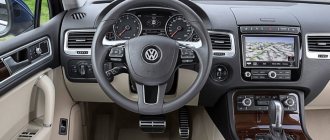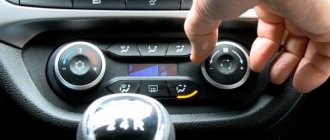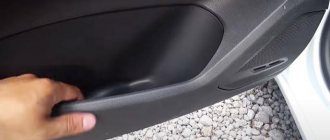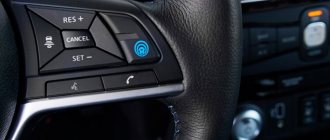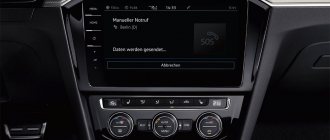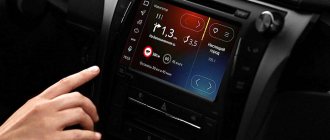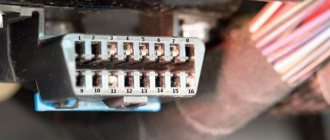One of the conveniences of modern vehicles is the presence of climate control and air conditioning. Many people think that climate control and air conditioning are the same thing, but this is not true. The main difference is that climate control constantly maintains the specified climate standards. The climate control system in the cabin can only be single-zone, that is, it directs air in only one direction, or it can be multi-zone, that is, the air supply source can be distributed around the perimeter of the cabin. In today’s article we will look at the reasons why the car’s climate control does not turn on, how to clean the climate control, the pros and cons.
Climate control in the car
Automotive climate control, abbreviated as CC, is a set of devices that control the set temperature in the car interior, regardless of the temperature outside.
The system includes:
- air conditioner;
- heater;
- temperature and humidity sensor;
- filtration system;
- electronic control unit (ECU).
CC is an electronic device whose operating principle is based on transmitting and receiving information from temperature sensors from different corners of the cabin to an electronic control unit. The driver sets what the temperature in the cabin should be, the system maintains this temperature, if it exceeds the set temperature, the system turns on the cooler, if it becomes cool, the system heats the air.
The difference between climate control and air conditioning is that the air conditioner only cools, while climate control consists of an air conditioner and a heater.
The air supplied is dried, so the glass does not fog up from the inside. Some brands of cars have air ionizers installed.
The climate control system is smart; if the air outside is dirty, the system automatically recirculates the air. The filtration system determines how much the maximum permissible norm of harmful substances in the air exceeds; if it does not exceed, the air enters from the outside.
Types and types of car climate control
CCs are classified by power, ease of use, number of work zones, and additional functions.
Types of climate controls by work area:
- Single zone.
- Dual zone.
- Three-zone.
- Four-zone.
How does a car's multi-zone climate control system work?
- The simplest system is a single-zone system that cools or heats only the driver and front passenger area.
- Dual-zone climate control, like single-zone climate control, directs air flow only to the driver and front passenger area. Only you can already regulate, you can set different temperatures for the driver’s zone and the passenger’s zone.
- Three-zone CC makes it possible to set the temperature of the area for rear passengers.
- Four-zone CC is the most advanced climate control.
Differences between air conditioning and climate control
The air conditioner cools and dries the air. The driver has to adjust the supplied temperature online.
The main difference is that the air conditioner does not have feedback, that is, you cannot set the desired mode.
Automatic operating modes of single-zone climate control
You can set the air supply to:
- legs;
- head;
- head and legs;
- windshield and feet;
- windshield.
Multi-zone, accordingly, have many different directions.
Via PC
Required
:
- Adapter ELM327, you can buy on AliExpress (see product catalog).
- Ddt4all() software.
How to activate the function
:
- Run ddt4all. Select a port. Select an adapter. Check the box and click Connect.
- In the window that opens, click the button marked with a circle (with a magnifying glass).
- Select search by CAN.
- We set the values in the left windows, as shown in the photo below.
- In the right window we find the parameter “CL_CountryCfg”
- Change the values (1-hot climate with a gradual change in temperature (default); 2-hot climate with a sharp change in temperature; 3-temperate climate; 4-cold climate)
- Enable Expert mode (in the menu at the top, second icon from the left).
- Save with the “CL_CountryCfg” button, which is located to the right of the zone number.
The process is also shown in the video:
Automotive climate control device
This system is complex, because it contains electronics, a cooler, and a heater.
It consists of:
- Electronic control unit.
- Temperature and humidity sensors.
- Executive mechanisms.
What does a car climate control system consist of
The ECU is the brain of the system. It includes a controller with program control and a data entry system. The operation is monitored by the ECU. It monitors the fan rotation speed, temperature information transmitted by sensors, and damper positions.
Sensors They are installed both inside the car and outside. Depending on how many zones the system has, the number of sensors is installed. They are mounted directly at the air flow outlet so that the temperature is displayed more accurately.
Actuators. This includes the heater itself (stove) and cooler (air conditioner), as well as fans, dampers, electric motors, air ducts, deflectors, and the like.
Functional features of the system
The number of possible climate control functions depends on the car model, its type and the sensors used. The list of features includes:
- maintaining the desired temperature by cooling the interior in the summer and heating in the winter;
- taking into account the ambient temperature using signals from a solar radiation analysis sensor, which determines the impact of ultraviolet radiation, as well as an outboard temperature sensor;
- recirculation and purification of air in the car interior, thanks to the presence of special filters;
- sophisticated temperature control in various areas of the cabin, including the driver's seat, passengers, rear seats and much more;
- prevention of glass fogging in the cabin in winter thanks to high-quality and uniform heating.
Air flow movement
A large number of drivers prefer climate control instead of air conditioning. Both solutions are designed for the sole purpose of maintaining a comfortable temperature in the cabin. But the air conditioner must be adjusted manually, and the climate system automatically adjusts the operating parameters.
How to use climate control
Those who bought a car with climate control for the first time immediately begin to ask questions about how to turn on the climate control, how to set it up, etc.
The standard designation for an on/off button is ON-OFF .
To turn on the air conditioner, the button is designated as A/C .
The maximum difference is usually made up to 5 degrees between zones.
For the system to maintain the temperature automatically, you need to press the AUTO .
To select the direction of air supply, use the flow direction buttons.
Climate control works better if the engine has a reserve of power, that is, if the car is driving in fifth speed at low speeds, then it is better to switch to fourth, the speed will increase, and the climate control will become easier to operate.
This is what the icon designations on the instrument panel of some Volkswagen models look like.
At least once a year, experts recommend checking the tightness of devices containing refrigerants. If the volume of the cooling refrigerant, which is most often freon, has decreased, then it needs to be refilled, usually by specialists who repair car air conditioners.
Recommendation: it is better to turn on the climate control no earlier than one minute after starting the internal combustion engine. The same applies to air conditioners. And before turning off the engine, it is recommended to turn off the cooling devices a minute before.
Malfunction prevention
In order for the climate control system in a car to work properly, it is necessary to periodically service its individual components. First of all, we are talking about the air conditioner radiator. Freon pressure should always be normal and should be monitored at least once a year.
Don't forget to periodically change the cabin ventilation filter . Especially if you frequently use the climate control system. Over time, it becomes clogged and the performance of the ventilation system decreases. And, of course, you have to breathe in the accumulated dust and germs. It is also necessary to clean the air conditioner radiator from dust accumulated on its surface. To do this, the system must be turned on periodically for ventilation, even in winter, at least once a month, for at least 5...10 minutes.
The third preventative measure is to clean the interior ventilation . There are several methods for this. For this purpose, special means are used - cleaners, aerosols, steam generators, “smoke bombs”. They effectively cleanse the system and destroy harmful microorganisms in it.
Installation of climate control
Those owners of cars that do not have climate control installed from the factory order installation or do it themselves. But it is not possible to install a climate control system on every car; it depends on the design of the stove, namely, whether it is possible to connect additional servos and run wiring under the dashboard.
To install climate control you will need:
- Electrical wiring, complete harness.
- Servo drives.
- Two temperature sensors that are mounted in the stove pipes.
- Two temperature sensors that are mounted in the central channels of the air duct.
- Fan sensor.
- Electronic control unit.
- Solar radiation sensor (optional).
What to do if the climate control system does not work
Like any other device, you can diagnose the climate control yourself. Depending on the make and model of the car, errors in the operation of the climate system in the car may be indicated differently.
For example, on a Nissan Tiida car, diagnostics are done in the following order:
- Turn on the ignition. Press the OFF to enter the climate control equipment into self-diagnosis mode. All relevant lights should light up.
- Raise the temperature one step, the number “2” will appear on the display. In this mode, electrical wires are checked for breaks. If the wires are all intact, then instead of the number “2” the number “20” should appear . If there is a problem in the circuit, then instead of 20 there may be other designations; this code must be looked at in the manual for deciphering error codes.
- We check the position of the mixers and airflow dampers. Here we increase the temperature by another +1, the number 3 should appear and self-diagnosis should begin. If there are no problems in this part, the number 30 will appear . If the designation is different, go to the manual and look at what the climate control error code is.
- We check the internal combustion engine of all dampers that exist. Raise the degree by one more unit. There are 6 different dampers in the car. The operation of each damper is checked by switching each of them individually and checking with your hand whether air flows or not.
- We check whether the sensors measure the temperature correctly. We cool the interior, if it is heated, ventilate it so that the data is more accurate. Again we raise the temperature by one unit. The number 5 should appear on the display screen . First, the test of the outside air temperature sensor begins. We press the air supply button to the windshield and the outside temperature should be shown on the screen at this time. After the next press of the same button, the temperature readings in the car interior should appear. We press this button a third time and the temperature of the intake air should appear (if the equipment is all Western, then in Fahrenheit, if for Russia and the CIS countries, then in Celsius).
- Correcting the temperature readings. You can manually set the temperature range correction for the temperature sensor from -3 to +3 degrees. To adjust the temperature, you must again set the temperature value to number 5.
For each model, the performance check may be different.
How does an air conditioner work?
Since recently there has been a rise in fuel prices and an economic crisis, many car enthusiasts are in favor of abolishing the use of car air conditioners. There are many recommendations for overall energy savings, and the use of integrated factory cooling is one of the main factors for poor fuel economy.
Opponents of air conditioners recommend using traditional ventilation, which is air entering through the window. Of course, this version is very impractical, especially in winter, when an open window can cause flu and inflammation. However, to choose the solution that's best for you, you should first consider the most common advantages and disadvantages of using air conditioning in your car.
Actively cooling the cabin with air conditioning can increase overall gasoline consumption by 10%. Research has shown that opening windows for ventilation when driving at an average speed of 70 km/h (or lower) will provide your car with maximum efficiency in terms of fuel consumption and comfort.
In most standard situations (driving around town, going to the mall, meeting with friends or relatives), it is easiest to always ventilate the car with natural air, unless the environment and temperature will cause you discomfort or affect the proper functioning of the vehicle. This way, from spring to fall, you can keep your car windows open when the heat allows, while keeping fuel consumption as low as possible.
Let's start with the refrigerant (r134a) inside the system. This refrigerant was specifically created for the automotive industry in the late 1980s and is somewhat different from household or industrial refrigerants. Some call it "Freon".
Some of the gas is held under pressure within the system. When the system is not operating, the refrigerant remains a gas under low pressure. The optimal property of the gas is its ability to come out of a hot state when it is compressed, and when cooled in a condenser located in front of the radiator, it turns into a pressurized liquid, which is then released through an expansion valve or diaphragm (small hole). The high-pressure liquid instantly turns into low-pressure vapor, which creates cold inside the evaporator, in which case the fan motor forces air through it into the ventilation system and into the inside of the machine.
The evaporator core looks like a small radiator that is located inside the car. Once the refrigerant has used up its cold charge, it is collected in a low pressure hose and to the compressor where it is processed again. Refrigerant is transferred from one component to another using hoses or pipes. The high pressure side hose connects the compressor to the condenser, from the condenser to the expansion valve or vented tube that is located in front of the evaporator. The low side connects the evaporator to the compressor. An expansion valve or diaphragm does essentially the same job, and the system may have one or the other. The expansion valve can be of different sizes depending on the temperature, while the diaphragm has a fixed size.
Car air conditioner
When is it good to use air conditioner?
If you exceed the speed of 70-80 kilometers per hour, as is usually the case on long trips to another city, it is better to keep the windows closed and use the air conditioning system. Open windows will increase fuel consumption by as much as 20%. Strong airflow slows the car down and makes it even more unstable, not to mention clunky to handle. But driving quickly with the windows closed is uncomfortable, so when driving at higher speeds, it is recommended to use air conditioning.
In addition to air conditioning, there are other solutions that allow you to ventilate your car and maintain comfort inside it. Firstly, the main fan of the car, if it is vented into the passenger compartment, can ventilate the car quite well and reduce its temperature. It can also change the smell in the car, namely, get rid of fuel or street “aroma”. It's best to use this setting to its maximum, but you can choose less intense settings if you prefer.
Another very simple way is to park your car in a parking lot or in a cool place in the shade. On a hot day you will benefit in terms of comfort and fuel consumption will be reduced.
Pros and cons of climate control
Of course, this system has more advantages and they outweigh the disadvantages. Each system has pros and cons, when there are more cons and they are more significant, then the question arises whether this system is necessary. But that's not the case in this case.
Pros of climate control:
- creates comfortable conditions for the driver and passengers;
- works automatically, set the mode once and turned it on;
- large selection of adjustments;
- human participation is minimized; there is no need to set the temperature every time;
- Usually the system is simple and you learn how to operate it quickly.
Minuses:
- high cost of the car if there is installed climate control;
- high cost of repair and refueling if it breaks;
- increases fuel consumption when the mode is on;
- impossible to repair yourself.
As you can see, the disadvantages are not so serious as to abandon the car’s climate control system. So what if the consumption is a little more, so what if the repairs are expensive, so what if the car costs a couple of tens of thousands of rubles more, but the ride is comfortable.
